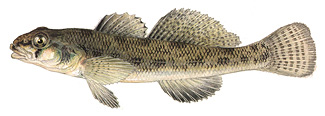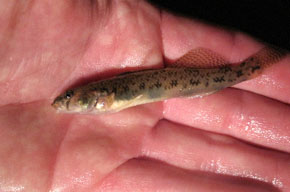Tessellated Darter
Etheostoma olmstedi
 Distribution: The range of the tessellated darter extends from the upper St. Lawrence River drainage in southern Quebec and the southern tributaries of Lake Ontario east to the Merrimack River and south along the Atlantic coastal drainages to the St. Johns River in Florida. Tessellated darters are abundant in the upper Connecticut River watershed. They are relatively common in the Merrimack River and some of its tributaries, but they are absent from the Androscoggin, Saco, and coastal drainages.
Distribution: The range of the tessellated darter extends from the upper St. Lawrence River drainage in southern Quebec and the southern tributaries of Lake Ontario east to the Merrimack River and south along the Atlantic coastal drainages to the St. Johns River in Florida. Tessellated darters are abundant in the upper Connecticut River watershed. They are relatively common in the Merrimack River and some of its tributaries, but they are absent from the Androscoggin, Saco, and coastal drainages.
Description: The tessellated darter can be recognized by dark spots resembling a "W" or an "M" on an elongate, cylinder-shaped body. On its light brown body, two dark streaks extend from the eye; one to the nose and one to the corner of the mouth. The tessellated darter may be distinguished from the swamp darter by its straight lateral line and a distinct groove separating the upper lip from the snout. Growth rarely exceeds two or three inches in length.
Species commonly confused with: Swamp darter
Habitat: The tessellated darter occurs in both flowing and standing waters but it shows a preference for quieter areas and, except during the breeding season, for sand or mud bottoms.

Life History: Male tessellated darters assume a dark, almost black color during their spring breeding. Depending on the local temperature regime, spawning takes place in the spring when the male chooses a location and guards it throughout the hatching of the eggs. Primary food sources include benthic invertebrates, primarily midge larvae, but other organisms, such as amphipods and copepods, are taken in smaller amounts.
Origin: Native
Conservation/Management: Tessellated darters are an important host species for the Federally Endangered dwarf wedgemussel. Mussel larvae, called glochidia, can only disperse by attaching to the gills of a host fish species. Maintaining healthy populations of tessellated darters is a critical component of efforts to protect and restore dwarf wedge mussel populations in the Connecticut River watershed.



